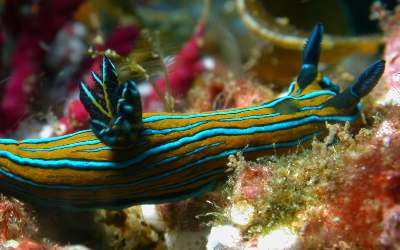
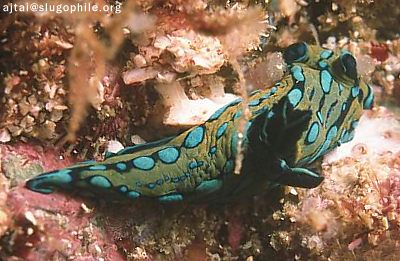
Tambja eliora
(Marcus & Marcus, 1967)
Order: NUDIBRANCHIA
Suborder: DORIDINA
Superfamily: ANADORIDOIDEA
Family: Polyceridae
Subfamily: Nembrothinae
DISTRIBUTION
Gulf of California. Also records on the Forum from Costa Rica and Ecuador.
PHOTO
Upper: Majahuitas, Bahia de Banderas, Pacific Coast of Mexico, June 18th, 45 feet deep, 43 mm long. Photo: Alicia Hermosillo.
Lower: Las Islas Murcielago, Costa Rica. 35ft, 25 April, 2002. Photo: Peter Ajtai.
The background colour varies from yellow-ochre to a darkish brown-grey. There are usually a series of longitudinal turquoise blue bands margined with a thin black line, but in specimens from Costa Rica the turquoise bands are broken into a series of elongate spots which are joined, like a string of beads, by a continuation of the black line which borders the spots. The gills are black with a blue line along the inside edge of the rachis. The outside edge of rachis is khaki or yellow ochre at base, and blue at tips.
The adults grow to 50mm in length but some larger specimens have been reported. Tambja eliora is also preyed on by Roboastra tigris. It is sometimes able to escape by swimming, which it does by flexing its body from side to side.
-
Farmer, W.M. (1978) Tambja and Roboastra (Mollusca: Opisthobranchia) from the Gulf of California and the Galapagos Islands. The Veliger, 20(4): 375-385.
-
Marcus, Er. & Marcus, Ev. (1967) American opisthobranch mollusks. Part 2, Opisthobranchs from the Gulf of California. Studies Tropical Oceanography, Miami 6(1-2): 141-256. (Figs 1-95).
Rudman, W.B., 2002 (May 22) Tambja eliora (Marcus & Marcus, 1967). [In] Sea Slug Forum. Australian Museum, Sydney. Available from http://www.seaslugforum.net/find/tambelio
Related messages
The origin of the name Tambja eliora
November 24, 2009
From: Eliora Gabai
Hello
My name is Eliora and i live in Israel.
A few days ago I found out about the sea slug Tambja eliora [message #14023] and I would like to know who gave it this name and why?
Thank you
Eliora
kalimero1987@walla.co.il
Gabai, E., 2009 (Nov 24) The origin of the name Tambja eliora. [Message in] Sea Slug Forum. Australian Museum, Sydney. Available from http://www.seaslugforum.net/find/22860Dear Eliora,
If you look at the species Fact Sheet you will see that the full species name is Tambja eliora (Marcus & Marcus, 1967). Ernst & Eveline Marcus were the scientists who named the species in an article published in 1967. I have done a quick check of the article but could find no reason why they named it 'eliora'. It is usual practice to provide an explanation when making new names but the Marcus's were not good at it, especially Ernst. For example in a large article on the Opisthobranchs of California (Marcus, 1961) the editor of the journal The Veliger insisted on explanations for the new names. After much correspondence the best they could get from Marcus was the note that 'some of the names are derived from folkloric names for seals'. Whether that was true or not, honour was satisfied and the paper was published.
A possible reason the Marcus's used the name eliora, which I see is of Hebrew origin, is their own background. They moved to Brazil from Germany before World War II to escape Hitler and the Nazis. My guess is that the name eliora was part of their cultural background - perhaps a friend or relative or just part of their history and literature. I'm am sure, if they were still with us, that they wouldn't mind if you adopted Tambja eliora as your own.
Best wishes,
Bill Rudman
Tambja eliora from the Galapagos Ids
June 13, 2005
From: Pam McPherson
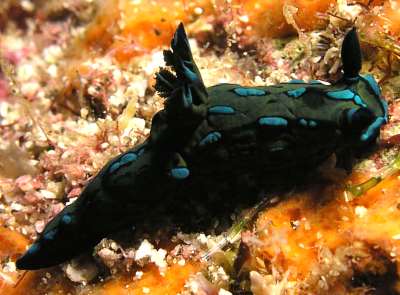
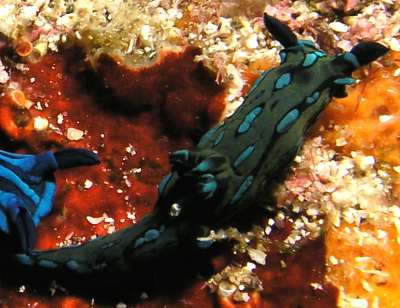
Note: I have repeated here part of Pam McPherson's earlier message [#13996] on Tambja from the Galapagos so there is a record under both species. - Bill Rudman..
I took the attached photograph on a recent trip to the Galapagos Ids. I have looked in all of the nudibranch identification books and asked the local divemasters and nobody seems to know anything about this nudibranch. Have you seen it before? Can you identify it?'
Locality: Wolf Island, Galapagos, Ecuador, East Pacific. Depth: 60 feet. Length: One inch. 7 March 2005. reef wall. Photographer: Pam McPherson
Please let me know your thoughts!
Pam McPherson
pammcp1@yahoo.com
McPherson, P., 2005 (Jun 13) Tambja eliora from the Galapagos Ids. [Message in] Sea Slug Forum. Australian Museum, Sydney. Available from http://www.seaslugforum.net/find/14023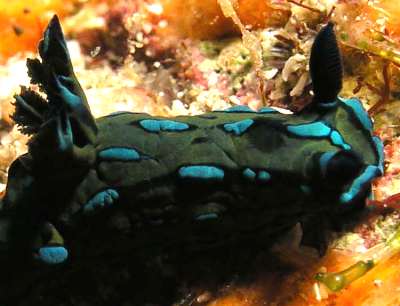
Dear Pam,
This is Tambja eliora, which to my knowledge has not previously been reported from the Galapagos Ids although we have a record on the Forum [message #10697] from mainland Ecuador. This species seems to have developed a spotted colour pattern in the southern part of its range, the colour pattern consisting of blue lines, with black borders in Mexico.
Best wishes,
Bill Rudman
Re: Tambja eliora from Ecuador
August 15, 2003
From: Alicia Hermosillo
Dear Bill,
I forgot the data for the picture in my earlier message:
Majahuitas, Bahia de Banderas, Pacific Coast of Mexico, June 18th, 45 feet deep, 43 mm long.
We have very little data on Tambja eliora. Hans Bertsch has been collecting data for it in Bahia de los Angeles (upper Gulf of California), where it is pretty abundant (seasonally). It is also common in the Pacific Coast of Baja and in La Paz. Then, for Bahia de Banderas, I have only recorded 2 specimens in over 400 hours of search the past 18 months... so I think it is safe to say it is very rare. There are no records of it anywhere else in the Pacific Coast of Mexico, which is no surprise since no research has been done on opisthobranchs. I have a friend who is a dive master in Oaxaca and has told me Tambja abdere is seasonally abundant there, just like it is here in Bahia de Banderas. Going south in the Pacific Coast, the next reports of Tambja (both species) are from Peter Ajatai in Costa Rica and this specimen from Ecuador. I did about 60 hours of survey in Panama last May but did not find any, still, seasonality could be the reason.
I hope this is of help to anyone.
Ali
gueri25@hotmail.com
Hermosillo, A., 2003 (Aug 15) Re: Tambja eliora from Ecuador. [Message in] Sea Slug Forum. Australian Museum, Sydney. Available from http://www.seaslugforum.net/find/10747Thanks Ali,
Bill Rudman
Re: Tambja eliora from Ecuador
August 13, 2003
From: Alicia Hermosillo

Dear Bill,
Concerning the Tambja from Ecuador message. Since this message is from my side of the Pacific, I would like to comment.
This picture I am sending is the typical Tambja eliora as described by Marcus & Marcus.
Since I first saw Peter´s picture I have wondered if it is in fact the same species. Marta Pola (Calif. Academy of Sci) is working on a worldwide revision of Tambja, Nembrotha and Roboastra. It would be very interesting to know what she has to say about this if she ever comes about one specimen to dissect. (If anyone out there would be so nice to send her some!)
Cheers
Ali
gueri25@hotmail.com
Hermosillo, A., 2003 (Aug 13) Re: Tambja eliora from Ecuador. [Message in] Sea Slug Forum. Australian Museum, Sydney. Available from http://www.seaslugforum.net/find/10725
Dear Ali,
I rely on comments from 'local experts' especially in regions such as the eastern Pacific, where there is so little published work. It's possible that the spotted animal is a separate species, but the only difference is that the blue lines have broken into a string of blue spots. It would certainly be interesting to confirm the suggestion that the colour pattern changes from lines to spots the further south you go down the east Pacific coast. Hopefully if Marta contacts Peter or Soledad, some specimens could be obtained. However I think that when you have very similarly coloured 'forms' like this, living in close geographical proximity, it is vital to study the variability of the whole population before deciding how many species there are.
I would appreciate some locality data for this photo.
Best wishes,
Bill Rudman
Tambja eliora from Ecuador
August 10, 2003
From: Soledad Luna
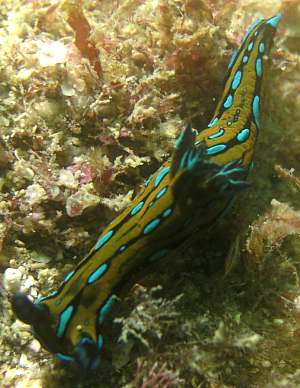
Hello,
We found this seaslug in a locality named Los Frailes in the coast of Ecuador [South America - east Pacific] in July 2003.
We are conducting a marine biodiversity project in the mainland Ecuador. There is not much information about this group in our country. Therefore we would like you to help us identifying this specimen.
Thank you very much
Soledad Luna
soledadl@mail.usfq.edu.ec
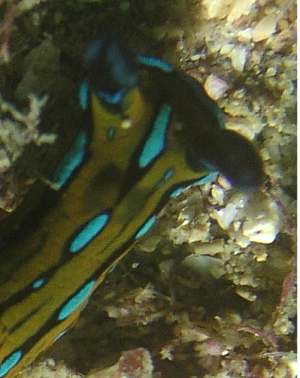
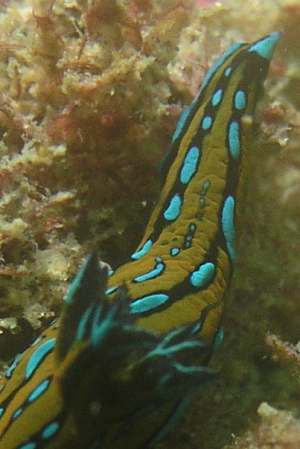
Dear Soledad,
This is Tambja eliora. As you will see from the Fact Sheet tbis species is quite common in the Gulf of California but not well-known further south. In the Gulf the colour pattern consists of blue stripes bordered with black, but from photos on the Forum from Costa Rica it seems the colour pattern changes further south and the blue stripe breaks up into a series of elongate spots. I know of no records of this species south of Costa Rica. We know little about the fauna of Ecuador so any photos of you have a opisthobranchs from your survey, even of species you can identify, would be welcome additions to the Forum
Best wishes,
Bill Rudman
Tambja eliora from Costa Rica
May 24, 2002
From: Peter Ajtai

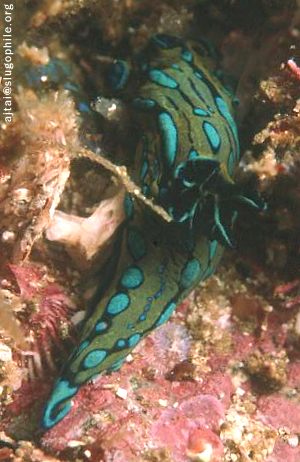
Dear Bill,
Here are some photos of a Tambja eliora, from Las Islas Murcielago, Costa Rica. It was found at 35ft on April 25th 2002 off an island composed of serpentine rock.
In Kerstitch's, Sea of Cortez Marine Invertebrates book, the photo of this species has continuous blue lines running down the length of its body instead of separated blue dots, like in the guy/gal? in the photos I took. Are they really the same species? I know that variations in color are very common within one species of nudibranch. To what extent are variations of pattern prevelant?
Cheers,
Peter Ajtai
ajtai@slugophile.org
Ajtai, P., 2002 (May 24) Tambja eliora from Costa Rica. [Message in] Sea Slug Forum. Australian Museum, Sydney. Available from http://www.seaslugforum.net/find/7032Dear Peter,
I am sure we will get some helpful information from people more familiar with this East Pacific fauna than I am. Certainly contuinuous blue lines seem to be the usual in photos I have seen but it is interesting that Erwin Koehler has photos by Fred Vogt which are spotted like in your photos - and like your animals they were also photographed in Costa Rica.
http://www.medslugs.de/E/Pac-E/Tambja_eliora.htm
Perhaps spotted animals are more common in the south of its range? It certainly may be worth following up.
Best wishes,
Bill Rudman
